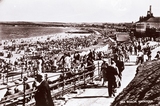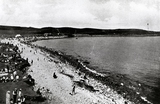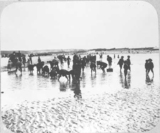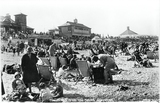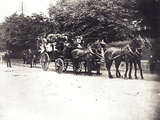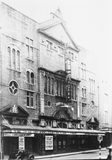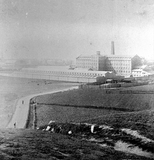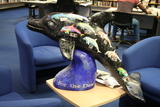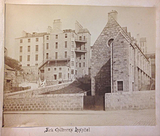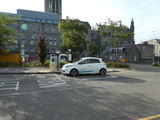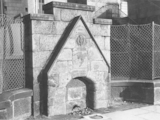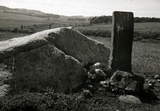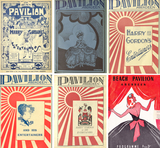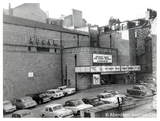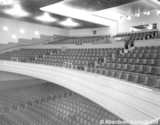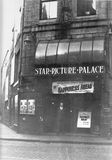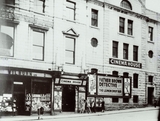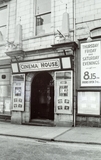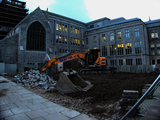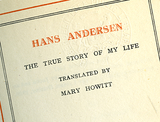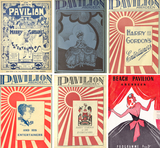|
Quick Search
|
Search Results
You searched for: More Like: 'Go for it'
100 items
items as
Aberdeen Sea Beach
51 The Promenade at Aberdeen Sea Beach, c. 1950 with the Beach Shelter and Beach Bathing Station in the background. Children catching shrimps at Aberdeen Sea Beach
341 Children catching shrimps at Aberdeen Sea Beach. Aberdeen Beach from the south
406 Aberdeen Beach from the south. A crowded day on the beach. Note the roof of the Beach Ballrooom at the right of the photograph. Quaker Meeting House
771 A photograph of the the Quaker meeting house that was located between Gallowgate and Sea Mount Place. This image shows the front elevation of the building that faced south east on to Port Hill.
The large scale Ordnance Survey town plan of Aberdeen (sheet LXXV.11.8., surveyed in 1867) indicates that their associated burial ground was located to the west of the building, towards Gallowgate. The plan also states that the meeting house had seating for 350 people.
The Quaker Meeting Houses Heritage Project (link here) states that the group first established their meeting house and burial ground on this site in 1672 and they continued to meet there until moving to a new location in 1800.
This building was later acquired by John Watt & Sons, leather merchants. The upper part had louvre windows which made it suitable for drying leather. Later OS maps suggest the building may have stood as a ruin into the mid-20th century.
At the time of writing in 2022, the site is now an elevated outdoor space surrounded by blocks of flats, to the south of Porthill Court, that go from Gallowgate around Seamount Road
A more recent, late-Victorian Quaker meeting house can be found at 98 Crown Street, Aberdeen.
To find out more about Quakers in Aberdeen, in addition to the above mentioned Quaker Meeting House Heritage Project, there is information on a relevant collection of books held by the University of Aberdeen, including a list of associated publications, here. MacPherson outing
1036 This image taken in 1902 shows a horsedrawn coach full of people ready to go on an outing. It had been organised by James MacPherson, joiner in Cults and the photo is taken at the east side of Kirk Brae. Such outings were commonplace at this period when firms organised day trips into the country for their employees. Bannermill from Broad Hill
1487 A photograph looking south west from Broad Hill towards the Bannermill (or Banner Mill) cotton works.
The road in the foreground is that which would become Links Road. This continued along the north side of the factory and had a junction with Constitution Street at the north east corner of the works. The land shown in front of Bannermill is Queen's Links.
The location of Bannermill is now occupied by a large square shaped complex of mostly early 21st century flats (completed 2004), with parking in its middle, and a main entrance, on Bannermill Place, accessed from Constitution Street.
The factory was established in 1827 by Thomas Bannerman and closed down in 1904, then under the management of Messers Robinson, Crum & Co. Limited.
The premises were used as stores and for various types of works during the 20th century.
In 1999 the 5.8 acres site was put on the market by the then owners, the North Eastern Farmers (NEF) co-operative, with a price of around £5million. NEF left the site in February 1999 to move to a new headquarters at Rosehall, Turriff. (See P&J, 11 November 1999, p. 7)
Aberdeen City Council subsequently produced a planning brief for developers calling for a housing or mixed housing and hotel development on the site.
Wimpey House submitted a plan for 349 luxury flats and this proposal was given the go-ahead. Construction primarily took place during 2002 and 2003, with the first residents moving-in in October 2002. The Aberdeen Boys School of Industry
1928 An illustration of the Aberdeen Boys School of Industry in around 1841.
The first Industrial School was opened on 1st October 1841 in Chronicle Lane. It was set up by Sheriff William Watson and was intended for the industrial training of boys between the ages of 8 and 14 years. These boys were the children of the poorest classes, and chiefly 'those who are found to infest our streets, begging and stealing.'
They were educated and provided with food and worked for a few hours per day at teasing wool, netmaking or gardening. Dinner was broth, beef and bread, or occasionally potato soup, or kail.
The boys would go home to their families after 8pm, but those who were homeless went to the House of Refuge.
Religious worship was also an important part of their regime. In the first six months of the school, 109 boys were admitted, although the average daily attendance was less than 60. It was reported that juvenile vagrancy and crime had decreased attendance at the Industrial School was made compulsory.
It was then found necessary to find a larger building in 1856 which eventually became Oldmill Reformatory. Industrial Schools existed until the mid 1930s. Alexander Ledingham Portrait
2140 This portrait of a woman is also by Alexander Ledingham of Rosemount. The photographer's stamp is present in the bottom right corner. The woman is standing by a chair that can be seen in other Ledingham portraits so this was obviously a recurrent prop. The painted backdrop in this picture suggests the setting of a large estate house.
The subject of the photograph wears a rather serious expression which was the convention in 19th and early 20th century photography. This was a continuation of the tradition of painted portraiture and suggested the stature and respectability of the subject. The great American writer Mark Twain wrote, "A photograph is a most important document, and there is nothing more damning to go down to posterity than a silly, foolish smile caught and fixed forever." Stillness was also required due to the exposure times of early photography. A School of Dolphins: Splash at Tillydrone Library
2154 Splash was chosen as a name due to it reflecting the movements dolphins make in the water. The children decided to decorate their own patterned dolphins to go onto Splash. Included next to each dolphin is the child's signed initials which is how they say their name/friend's names to other peers etc. within Aberdeen School for the Deaf. We wanted to include them to distinguish the involvement of sign in their education here at Aberdeen School for the Deaf. Stop 4: Health Services for Women and Children - Agnes Thomson (1880-1952) Clementina Esslemont OBE (1864-1958) Fenella Paton (1901-1945) and Mary Esslemont (1891-1984)
2303 The first sick children's hospital on site of former Naval Surgeon's Dr Blaikie surgery on 6-8 Castle Terrace in 1877 extended to take in Castle Brae Chapel. An unsung heroine that worked on this site is Dr Agnes Thomson (nee Baxter) a graduate from Aberdeen University who served as an anaesthetist at the Sick Children's and Maternity Hospitals during the First World War. Agnes Thomson was instrumental in founding the Aberdeen Mother and Baby Home and volunteered her services to the Mother and Child Welfare Association, which was established to address the shockingly high death rate of babies and toddlers in the east end of Aberdeen.
Throughout her life, Clementina Esslemont OBE was a champion of liberal ideas and good causes and well known for her no-nonsense approach to social service provision. One of her principal achievements was the foundation of the Aberdeen Mother and Child Welfare Association in 1909, which played an important role in social service and public health provision in the City of Aberdeen until the creation of the Public Health Department in 1949. She was also involved in the establishment of a model block of tenements on the Spital, Aberdeen, in the formation of Aberdeen Lads' Club, St Katherine's Club, and the nursery school movement.
Dr Mary Esslemont, one of Clementina Esslemont's daughters, worked as a Gynaecologist at the hospital. Mary did much to improve the care and wellbeing for mothers and babies with her determination and hard work. As well as being the Gynaecologist she also ran prenatal and family planning clinics. Mary was an advocate of women's rights, health education and family planning. She was the first female president of the Student University Council and the first woman to be president of Aberdeen Liberal Association in 1954. Awarded the CBE in 1955, Aberdeen City Council bestowed the Freedom of the City of Aberdeen in 1981.
Aberdeen has also led the way in family planning with a remarkable woman at the forefront of fertility control. Pioneer Fenella Paton opened Aberdeen's first family planning clinic in 1926 at Gerrard street. The clinic, the first of its kind in Scotland, moved to new premises in Castle Street in 1948. But prior to these clinics and innovations in family planning there were large families and mothers that needed to go out to work and at our next stop an initiative was put in place to help these working women.
Memories:
Norma Michie speaking about Mary Esslemont
Audrey's memories of the Family Planning Clinic
Denise's memory of the Family Planning Clinic
Heather's memories of Ina Lawrence and the Children's Hospital
Alma Duncan's memories of Cocky Hunters Co-Wheels Electric Car on Queen Street
2773 This photograph taken on 14th July 2018 shows a Co-Wheels electric car at a charging station on Aberdeen's Queen Street. The south side of Marischal College is in the background.
Co-Wheel's are a social enterprise whose website describes themselves as "the only independently-owned national car club, providing low emission, hybrid and electric cars on a pay-as-you-go basis for organisations and communities across the UK" (accessed 03/08/2018). Well of Spa
3108 A photograph of the Well of Spa in around 1969 at its second location, on Spa Street, in the western periphery wall of Woolmanhill Infirmary. This site is still identifiable today by the curving recess in the low wall and the now leveled out supporting wall, both shown in this image.
A digital copy of this image was kindly given to Aberdeen Local Studies by our colleagues in the Masterplanning, Design and Conservation Team.
It was the then Department of Planning and Building Control that oversaw the restoration and relocation of the structure to its current site outside Denburn Car Park in 1976/77. The plans were drawn up by Aberdeen City Council planner John Soutar. In reference to the well's Woolmanhill location he was quoted in the newspaper saying "The Victorians were great for shifting things and they weren't fussy where they put them."
The stone structure, which was built in around 1635, was previously located on the western side of Spa Street, in front of Garden-Nook Close. This location can be viewed on the 1867 Ordnance Survey town plan of Aberdeen (sheet LXXV.11.12) and in other photographs on this site.
The 1970s restoration and relocation of the well was advocated by councillor Frank Magee. The project, estimated to cost £4,500, was met with opposition and it was only given the go-ahead after considerable debate.
The restoration of the well was carried out by a masonry firm, based in Birnie, called Moray Stonecutters. It was temporarily transported to Elgin for the work. An additional £4,500 was spent in the creation of a new garden surrounding the well by a Job Creation team. It was called the Four Neukit Garden in reference to the old amenity gifted to Aberdeen, along with the original stone structure, by the portrait painter George Jamesone.
Coverage of work on the well can be read in local newspapers from the time. The finishing touches on the well's final relocation were reported in the Evening Express of Saturday, 22nd October 1977, page 16. March Stone 31 (plus Doupin' Stone)
3213 This stone is located in the same field north of Wynford. It is marked "31 ABD". The line of the marches from number 30 has left the Littlemill Burn, for the Blind Burn, and headed north a short distance.
The descriptions in 1525 and 1698 there had not been a marker stone here at those times. In 1780 two large earthfast stones were noted, both saucer marked.
It was here that new burgesses underwent the initiation of "doupin'", or being dropped onto the stone. This took place during the Riding of the Marches. The Doupin' cup stone is next to the lettered stone.
This is the north west corner of the Freedom Lands. However, the boundary line does go further north that this point; north east to stone number 34 at Greenwelltree, later Craibstone Golf Course.
A slide of this image was kindly lent to Aberdeen City Libraries by Colin Johnston so that we could create a digital copy for public use.
The image was taken in the early 1980s when Colin worked as a teacher at Bridge of Don Academy. He led several current and former pupils, and staff members in an investigation into the location, physical condition and public knowledge of Aberdeen's historic boundary markers. Aberdeen Theatres: Pavilion programmes
3382 For more than 30 years Harry Gordon, one of Scotland's most talented comedians of the 20th Century, dominated Aberdeen's entertainment industry and prompted local historian Fenton Wyness to describe him as "possibly the only real attraction Aberdeen beach has ever had". Aberdeen Local Studies hold a collection of bound volumes of Beach Pavilion programmes, published between 1924 and 1940.
The Beach Pavilion opened in 1905 and later became the home of Harry Gordon, the Laird of Inversnecky and one of Aberdeen's most popular comedians. He entertained visitors at the Beach Pavilion throughout the 1920s and 1930s, helping to make the Beach Pavilion one of the brightest and best places of entertainment in town and brought many world-famous artists to Aberdeen.
The final curtain came down with the Second World War. Due to its vulnerable location, many people were reluctant to go the Beach and the Pavilion was closed during the war years. It was re-opened in 1946 (although Harry Gordon had given up his tenancy by then) and continued as an entertainment venue. Aberdeen Cinemas: Regal / ABC / Cannon
3396 An Aberdeen Journals Archive photograph of the Shiprow entrance to the Regal cinema in February 1961. The cinema is advertising showings of Saturday Night, Sunday Morning with Albert Finney, Linda with Carol White and Alan Rothwell, and Pathé News.
The Regal was opened on Monday 26th June 1954 by Associated British Cinema (ABC). The opening of this substantial cinema was the conclusion of a long and much delayed enterprise.
This Shiprow site was previously the location of Aberdeen's first permanent cinema, Dove Paterson's Gaiety. It had later become the Palladium and had laid shuttered for close to seven years when the owner put the site up for sale in early 1937.
Bert Gates of Aberdeen Picture Palaces (APP) put in an offer and made plans to build a very large cinema at the location. Michael Thomson in Silver Screen in the Silver City (1988) suggests that had this plan gone ahead it would have made the local company a force with which to be reckoned.
Gate's plans were thwarted however when another offer for the property from ABC (Cinemas) was accepted. ABC were a major cinema operator throughout the UK, at the time second only to the Rank Organisation, which owned the Odeon and Gaumont chains. ABC's arrival in Aberdeen would offer stiff competition to local companies such as APP. Both in terms of having the best venues and having the best films to show in them.
ABC's arrival in Aberdeen did not go smoothly, however. It was not until 1939 that the cinema's plans received official approval. War was declared not long after construction had begun and in 1941 the project was stopped by government restrictions that halted the construction of non-essential buildings where roofing had not already been started. Only the outer shell had been built at Shiprow and the building would subsequently lie incomplete for over a decade.
After much campaigning, including by local MP Hector Hughes, the government finally gave its consent and on 28th October 1953 ABC announced that work on the Regal would recommence. The plans for the cinema were modernised and construction was quickly finished.
The completed Regal was an impressive, modern cinema with a seating capacity of 1,914. Its inaugural film was The Knights of the Round Table and the opening gala was attended by stars Richard Todd and Anne Crawford.
[Information primarily sourced from Silver Screen in the Silver City (1988) by Michael Thomson]
Image © Aberdeen Journals Ltd. Aberdeen Cinemas: Regal / ABC / Cannon
3400 An Aberdeen Journals Archive photograph of the interior of the ABC Cinema on Shiprow and Union Street in 1976. This was shortly after the "tripling" of the cinema which was completed on 8th July 1974. This was the process of dividing the cinema's original, single large auditorium into three distinct screening rooms. This allowed cinemas to show a greater variety of films and to cater to smaller audience numbers. The Odeon on Justice Mill Lane had been the first cinema in Aberdeen to be tripled, reopening as such on 8th April 1974.
This photograph shows ABC 1, the largest screen, that sat 566 people. Silver Screen in the Silver City (1988) explains that the largest screen (cinema one) would mainly show first runs. The smaller screens (cinemas two and three) would be used for less commercial attractions or the retention of popular features already shown in the main screen. This is the format of cinema exhibition that is most common today but marked a significant change from the tradition of single large auditoriums.
The tripling of major circuit cinemas like the ABC and Odeon had a knock-on effect on the viability of cinemas such as The Cosmo on Diamond Street. These smaller cinemas had previously been a home for the less commercial features that the larger venues were now taking on.
In 1986 the ABC Cinemas chain became part of the American-based Cannon company, which already had extensive cinema interests in the UK. The vertical ABC sign above the Union Street entrance gave way to the Cannon logo in June 1987.
Some highlights of the cinema's time as the Cannon included hugely popular runs of E.T., the Tim Burton Batman, and Robin Hood Prince of Thieves. The cinema's name reverted to the ABC for a period before closing for the final time in early 1998.
Aberdeen and cinema-going was shortly to experience a period of expansion. In August 1999 Aberdeen company Craiglair Properties got the go-ahead to demolish the abandoned ABC and build a new seven screen cinema on the site. The cinema was called The Lighthouse and opened in April 2001. Since 2004 it has operated as The Vue Aberdeen.
[Information primarily sourced from Silver Screen in the Silver City (1988) by Michael Thomson]
Image © Aberdeen Journals Ltd. Aberdeen Cinemas: Star Picture Palace
3409 A photograph of the Star Picture Palace at the junction of Park Street and South Constitution Street in the 1920s. The cinema was an undertaking of Bert Hedgley Gates in partnership with his wife Nellie and with financial backing from local businessmen. Bert Gates was among Aberdeen's most influential cinema proprietors. He would go on to be the founding managing director of Aberdeen Picture Palaces, a highly successful company that would play a key role in cinema exhibition in the city.
The ever useful Silver Screen in the Silver City (1988) by Michael Thomson details much of the history of the Star Picture Palace, known as The Star or Starrie, and the activities of Bert Gates. The cinema was converted from the former premises of the Aberdeen East End Mission. Its name was thought to come from a red-stained glass window in the shape of a star that was a legacy of its previous use. The Star's auditorium stood on the south side of South Constitution Street and its entrance, as shown here, was at 23 Park Street, underneath a block of tenements.
The cinema opened in March 1911 and showed a mixture of films and music. Bert and Nellie would stand behind the screen and add dialogue, sound effects and commentary to the silent films being shown. They also added topical references and allusions to well-known local figures. Both had backgrounds as stage artistes and their performances became a popular feature of the Star.
In 1913 the successful cinema was expanded, doubling its capacity, as Aberdeen Picture Palaces acquired the building and some houses to its rear. Thomson states that the remodelled Star was advertised as "Absolutely the Finest and Most Handsome Interior Out of Glasgow".
The Star had direct competition when the Casino cinema opened just around the corner on the north side of Wales Street on 7th February 1916. Thomson suggests that Gates responded to the Casino's popular and innovative cine-variety performances by programming his own varieties and mini revues. These included Miss Madge Belmont, "America's Handcuff Queen" and Birteno's Golden Grotto, "the most gorgeous electrical dance spectacle ever seen in Aberdeen - a display of serpentine and fire dancing by Belle Lumière, with marvellous kaleidoscopic colour effects".
The Star Picture Palace showed its first talkie, King of the Khyber Rifles, on 13th October 1930. In November 1932 the cinema suffered a fire caused by a dropped cigarette. The damage was relatively minor however and only put the Star out of action for a fortnight.
By the beginning of the second world war, the area around the Star was becoming depopulated as housing on Hanover Street and Albion Street was demolished to make way for the new Beach Boulevard. Bert Gates acquired control of the Casino in November 1939 with the idea of combining it with the Star to create one super-cinema that fronted onto the new thoroughfare.
Thomson explains that business was concentrated on the Casino and later that month the Star closed as a cinema for good. In 1939/40 it served as an indoor fun-fair and as the Boulevard Ballroom for the remainder of the war. The Star building was demolished, at the same time as the Casino, in 1971 to make way for a housing development.
Michael Thomson addresses the use of jam-jars for cinema admission in the first appendix to Silver Screen in the Silver City (1988). This includes an account of the Star Picture Palace from Ethel Kilgour who remembered going there as a child. Her description concludes as follows: "It was a great little cinema, jam-jar entry fee and all, and it was a form of escapism for so many children in a world so depressed between the wars".
[Information primarily sourced from Silver Screen in the Silver City (1988) by Michael Thomson] Aberdeen Cinemas: Picturedrome / Cinema House
3411 The Cinema House was located at the corner of Union Terrace, Skene Terrace and North Silver Street. The building was designed by Arthur H. L. Mackinnon and originally built in 1897-1898 as a clubhouse for the Aberdeen Union Club. Mackinnon (1870-1937) was a local architect who also designed the Aberdeen Fire Station on King Street and Mile End School.
The building's first recorded use for cinematographic purposes was a New Year Holiday Carnival organised by the pioneering Aberdeen cinematographer and exhibitor William Walker in December 1901. Alongside an early picture show the extravaganza featured the popular fiddler James Scott Skinner and a conjurer called Harry Marvello.
It was a Londoner by the name of Henry N. Philips who came to Aberdeen and in June 1910 converted this building into Aberdeen's second permanent cinema: the Picturedrome. The enterprise was a great success and Philip's formed a company called British Animated Pictures to run the cinema.
The 'Drome's first manager was Harry Fenton. He also appeared on the cinema's stage as a singer. This was a time when cinemas would often show a mixture of films and variety performances. The venue had a pianist called Hal Scott who would accompany performances and provided musical ambience.
The Picturedrome was noted for showing the film productions of Thomas Edison's Edison Studios and for consistently good stage turns.
In 1923 the Picturedrome/Union Club block was sold to the Loyal Order of Ancient Shepherds. They were one of the 19th century friendly societies in which people would band together prior to the development of more comprehensive welfare provision. The Shepherds continued to run the cinema for a period. A sign for the society can be seen in the top left of this image.
In May 1924 the cinema was taken over by James F. Donald. He was the patriarch of the Donald family that played a prominent role in the history of cinemas and theatres in Aberdeen. Restored and improved, the venue reopened on the 11th August of that year as the Cinema House. Donald initially held the premises on a 20-year lease, but would go on to buy the property outright.
This photograph, taken from in front of the Central Library, dates from around 1934 and shows the cinema advertising Father Brown Detective and The Lemon Drop Kid. Also visible next door at 2 Skene Terrace is a branch of the successful grocer and provision merchants, Wilburn Ltd.
[Information primarily sourced from Silver Screen in the Silver City (1988) by Michael Thomson] Aberdeen Cinemas: Picturedrome / Cinema House
3413 This photograph shows the Picturedrome/Cinema House building in the mid-to-late 1970s, after it had ceased being a cinema. As with many cinemas at the time, it was converted into a bingo hall. In 1981 it was rechristened Casino Bingo.
In the Evening Express of 22nd December 1986 it was announced that Coral Social Clubs of Nottingham had purchased the Kingsways on King Street and Casino Bingo on Skene Terrace. Both were former cinemas owned by James F. Donald (Aberdeen Cinemas) that were then operational as bingo halls.
The chairman of James F. Donald (Aberdeen Cinemas), Richard Donald, confirm the sale of the venues and expressed sadness to see them go, particularly the old Cinema House hall that had been in the family firm for over 50 years and that he had managed as a 14-year-old. Both venues were retained as bingo halls by Coral Social Clubs, which later became known as Gala Bingo.
In 1995 the Cinema House building was redeveloped and opened as a 350-capacity live entertainment centre. It was named the Playhouse after the old Donald owned cinema located at the west end of Union Street.
The new Playhouse offered live music, cabaret and dancing. At the time of opening a spokesperson for the owners, Balgownie Development Company Ltd., said "We're offering a full night's entertainment where they can come in have a meal and enjoy a night of cabaret and dancing all under the one roof". Interior changes were kept to a minimum in the redevelopment to retain the atmosphere (Evening Express, 21/10/1995, p. 4).
1995 also saw the opening of the Stage Door Restaurant in the North Silver Street side of the building. The eatery was from the same team that operated Aberdeen's Courtyard Restaurant and retained a number of design features from its time as a cinema. The restaurant had an impressive large bowed ceiling and theatre related wall illustrations. This space was later occupied by a computer gaming and esports hub called Engage Gaming. In 2020 this company changed their name to Reset Gaming and moved to premises on John Street.
After the Playhouse, the main part of the building was occupied by the Forum from 1998 and operated as a well-known concert and events venue. Most recently it was a venue called The Assembly, which sadly closed down in 2019. Site of McKay's
3498 A photograph from 24th February 2021 showing the cleared former site of McKay's clothing shop at 29-31 Queen Street. The business relocated to new premises at 251-253 Great Northern Road in early 2020.
The Queen Street site was sold to Aberdeen City Council in 2019. The building was demolished in the early months of 2021 as a preliminary stage of the authority's Queen Street regeneration project.
The £150 million transformation includes plans for 300 new homes, a civic hub, cultural assets, enhanced heritage features and a high-quality public realm.
McKay's opened their two-floor premises on Queen Street on 25th March 1971. The family business, which has been on the go since the early 20th century, had previously occupied two other locations on Queen Street. The latter Queen Street premises was famous for its abundant and varied stock.
The eastern exterior wall of the building was the site of a large mural depicting a golfer by Norwegian artist Martin Whatson. This was created for Aberdeen's first Nuart festival in 2017 and sadly had to be demolished along with the building.
The rear of A. Marshall Mackenzie's Greyfriars Church of 1903 can be seen on the left of this image. Treasure 29: The Snow Queen and Hans Christian Andersen
202 Hans Christian Andersen wrote 'The Snow Queen' in 1844. Aberdeen City Libraries hold a number of interesting resources relating to the author. Perhaps the most notable is a 1926 reprint of his autobiography 'The True Story of My Life' translated by Mary Howitt and published by George Routledge & Sons.
Born in Odense, Denmark in 1805, Andersen wrote three autobiographies during his lifetime. 'The Book of My Life', written in 1832 aged 27, was for close friends, the Collin family, and was not intended for publication. 'The True Story of My Life' in 1846 was to accompany a German edition of his collected works and his final autobiography, 'The Fairy Tale of My Life', was published in 1855.
Mary Howitt (1799-1888) was an English author who came to prominence as a translator of Scandinavian literature, in particular eighteen volumes of the Swedish novelist Frederika Bremer (1842-1863) and many translations of Hans Christian Andersen. In the 1926 preface to 'The True Story of My Life' Scottish author and poet, Violet Jacob, claims that Howitt's "precise and innocence English" is the ideal vehicle for conveying Andersen's writing. It was through Howitt's translations that the English speaking world first came to know Andersen's work.
Howitt dedicates her translation of 'The True Story of My Life' to the Swedish opera singer Jenny Lind (1820-1887). Lind was world famous for her immaculate voice, generosity and strong religious convictions. She and Andersen were good friends. When Lind rejected Andersen as a suitor she became the model for the Snow Queen with a heart of ice. Their friendship endured nonetheless and in 'The True Story of My Life' Andersen explains the central influence Lind had on his work: "Through Jenny Lind I first became sensible of the holiness there is in art; through her I learned that one must forget oneself in the service of the Supreme. No books, no men have had a better or a more ennobling influence on me as the poet, than Jenny Lind, and I therefore have spoken of her so long and so warmly here."
The autobiography also contains other glimpses into the inspiration behind 'The Snow Queen'. For example, Andersen's childhood surroundings are said to have inspired the roof top garden on which the story's heroes, Gerda and Kai, first meet and become friends: "Our little room, which was almost filled with the shoemaker's bench, the bed, and my crib, was the abode of my childhood; the walls, however, were covered with pictures, and over the work-bench was a cupboard containing books and songs; the little kitchen was full of shining plates and metal pans, and by means of a ladder it was possible to go out on the roof, where, in the gutters between and the neighbour's house, there stood a great chest filled with soil, my mother's sole garden, and where she grew her vegetables. In my story of the Snow Queen that garden still blooms." Treasure 65: Beach Pavilion Programmes
241 For more than 30 years Harry Gordon, one of Scotland's most talented comedians of the 20th Century, dominated Aberdeen's entertainment industry and prompted local historian Fenton Wyness to describe him as "possibly the only real attraction Aberdeen beach has ever had". Aberdeen Local Studies hold a collection of bound volumes of Beach Pavilion programmes, published between 1924 and 1940.
The Beach Pavilion opened in 1905 and later became the home of Harry Gordon, the 'Laird of Inversnecky' and one of Aberdeen's most popular comedians. He entertained visitors at the Beach Pavilion throughout the 1920s and 1930s helped to make the Beach Pavilion one of the brightest and best places of entertainment in town, bringing many world-famous artists to Aberdeen.
The final curtain came down with the Second World War. Due to its vulnerable location, many people were reluctant to go the Beach and the Pavilion was closed during the war years. It was re-opened in 1946 (although Harry Gordon had given up his tenancy by then) and continued as an entertainment venue. In 1962 the Pavilion was re-named the Gaiety and became a licensed restaurant, public bar and lounge. It then functioned as a restaurant in the Queens Links leisure complex but the remaining remnants of the original building were sadly destroyed by fire in May 2014. |



